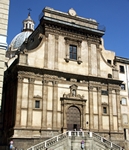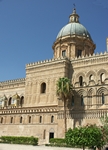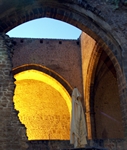
|
ITALY: Cinque Terre | Mondello | Palermo | Segesta |
|
Pictures of Palermo
Other images from Siciliy. mondello | palermo | Segesta | index Except where noted, all images are the property of Rhett A. Butler, copyright 1994-2004. Contact me with questions regarding use, reproduction, or purchase of any of the pictures. Recommended travel guides on Italy Recommended travel guides on the Palermo: Palermo [Wikipedia]: History Palermo was founded in the 8th century BC by Phoenician tradesmen around a natural harbour on the north-western coast of Sicily. The Phoenician name for the city may have been Z�z, but Greeks called it Panormus, meaning all-port, because of its fine natural harbour. Palermo is widely considered to be the most conquered city in the world, as the following history will show. Palermo remained a Phoenician city until the First Punic War (264-241 BC), when Sicily fell under Roman rule. The Roman period was one of comparative calm, Palermo coming under the provincial administration in Syracuse. When the Roman Empire was split, Sicily and Palermo came under the rule of the Eastern Byzantine Empire. This lasted until the 9th century, when Muslim forces from north Africa invaded, taking Palermo in 831 and all of Sicily by 965. The Muslim rulers moved Sicily's capital to Palermo where it has been ever since. In the Muslim period Palermo was a major city of trade, culture and learning, with (it is said) more than 300 mosques. The city was renowned throughout the Muslim world. It was a period of prosperity and tolerance, as Christians and Jews were allowed to live in peace. In 1060 the Normans launched a crusade against the Muslim emirate of Sicily, taking Palermo on January 10, 1072 and the whole island by 1091. The policy of tolerance continued under the Norman rulers, though the mosques were converted into churches. The resulting blend of Norman and Arab culture fostered a unique hybrid style of architecture as can be seen in the Palatine Chapel, the church San Giovanni degli Eremiti and the Zisa. [1] The Norman dynasty did not last, and Sicily in 1194 fell under the control of the Holy Roman Empire. Palermo was the preferred city of the Emperor Frederick II, who is buried in the cathedral. After an interval of Angevin rule (1266-1282), Sicily came under the house of Aragon and later, in (1479), the kingdom of Spain. As the seat of the Spanish viceroy, Palermo grew in population from 30,000 in the mid-15th century to 135,000 on the eve of the plague of 1656. In the 15th and 16th centuries Palermo was adorned with a large number of baroque buildings, many of which still exist today. Sicily's unification (1734) with the Bourbon-ruled kingdom of Naples as the kingdom of the Two Sicilies inflicted a devastating blow on the elite of Palermo, as the city was reduced to just another provincial city, the royal court residing in Naples. Palermo and its many palaces fell into decay. Palermo was the scene (January 12) of the first of Europe's revolutionary upheavals of 1848 and held out against the Neapolitan crown until May 1849. The Italian Risorgimento and Sicily's annexation (1860) to the kingdom of Italy gave Palermo a second chance. It was once again the administrative centre of Sicily, and there was a certain economic and industrial development led by the Florio family. In the early 20th century Palermo expanded outside the old city walls, mostly to the north along the new boulevard, the Via della Libert�. This road would soon boast a huge number of villas in the style of Art Nouveau or Stile Liberty as it is known in Italy, many of which were built by the famous architect Ernesto Basile. The Grand Hotel Villa Igeia, built by Ernesto Basile for the Florio family, is a good example of palermitan Stile Liberty. The Teatro Massimo was built in the same period by Basile and his son and was inagurated in 1897. 20th Century Palermo survived almost the entire fascist period unscathed, but during the Allied invasion of Sicily in July 1943 the harbour and the surrounding quarters were bombed heavily by the allied forces and were all but completely destroyed. Six decades later the city centre had still not been fully rebuilt, and hollow walls and devastated buidings are commonplace. The importance of Palermo got another boost when Sicily became (1947) an autonomous region with extended self-rule. Palermo again was the seat of a parliament, as it had been in the Middle Ages, and the future looked bright. Unfortunately, many opportunities were lost in the coming decades, due to incompetence, incapacity, corruption and abuse of power. The reduced importance of agriculture in the Sicilian economy led to a massive migration to the cities, and mostly to Palermo, that swelled in size. Instead of rebuilding the city centre the town was thrown into a frantic expansion towards the north, where practically a new town was built. The regulatory plan for the expansion was largely ignored, as contractors bribed the city officials who themselves profited massively from the "sacking of Palermo", as it was commonly called. New parts of town appeared almost out of nowhere, but without parks, schools, public buildings, proper roads and the other amenities that characterise a modern city. The Mafia played a huge role in this process, which was an important element in the Mafia's transition from a mostly rural phenomenon into a modern criminal organisation. At the turn of the 21st century, Palermo is still struggling to recover from the devastation of World War II and the damage caused by decades of uncontrolled urban growth. The historic city centre is still partly in ruins, the traffic is horrific, and poverty is widespread. Being the city in which the Italian Mafia historically had its main interests, it has also been the place of several recent well-publicized murders. Palermo is a city with monumental problems, but is also a city of almost three millennia of history, beautiful palaces and churches, colourful markets, marvelous food and a distinctive cultural identity. Interesting Sights The Cathedral has a heliometer (solar "observatory") of 1690, one of a number1 built in Italy in the 17th and 18th centuries. The device itself is quite simple: a tiny hole in one of the minor domes acts as Pinhole camera, projecting an image of the sun onto the floor at solar noon (12:00 in winter, 13:00 in summer). There is a bronze line, la Meridiana on the floor, running precisely N/S. The ends of the line mark the positions as at the summer and winter solstices; signs of the zodiac show the various other dates throughout the year. The purpose of the instrument was to standardise the measurement of time and the calendar. The convention in Sicily had been that the (24 hour) day was measured from the moment of sun-rise, which of course meant that no two locations had the same time and, more importantly, did not have the same time as in St. Peter's Basilica in Rome. It was also important to know when the Vernal Equinox occurred, to provide the correct date for Easter. The "solar clock" can be up to 16 minutes fast or slow. The reason for this is explained fully in Main Articles Analemma and Equation of time, but can be summarised thus: the earth rotates on its axis every 24 hours but it also orbits the sun. Thus the sun will appear directly over the same spot increasingly early (or late) each day. The correct track to draw on the ground is a figure 8 rather than a line. One site of interest is the Capuchin Catacombs, with many mummified corpses in varying degrees of preservation. Close to the city is 600 meter high Monte Pellegrino, with spectacular views of the city, its surrounding mountains and the ocean. The astonishing stucco work of the baroque sculptor Giacomo Serpotta can be seen in many of the city's churches but his masterpiece must be the Oratorio del Rosario in Santa Cita (or Santa Zita). Patron Saints The patron saint of Palermo is Santa Rosalia, who is still widely venerated. On the 14th of July, people in Palermo celebrate the "Festino", which is the most important religious event of the year. The Festino is a procession in the main street of Palermo to remember the miracle attributed to Santa Rosalia who, it is believed, freed the city from the Black Death in 1624. The cave where the bones of Santa Rosalia were discovered, is on Monte Pellegrino (see above): when her relics were carried around the city three times, the plague was lifted. There is a Santuario marking the spot and can be reached via a scenic bus ride from the city below. Before 1624 Palermo had four patron saints, one for each of the four major parts of the city. They were Saint Agatha, Saint Christina, Saint Ninfa and Saint Oliva. Transport Palermo International Airport is located 32 km (19 miles) west of Palermo. Buses departs roughly every 30 minutes from the central railway station (via Piazza Ruggero Settimo) to the airport, and can sometimes during rush hour take more than an hour. |
what's new | rainforests | tropical fish | for kids | search | about | copyright & use | contact |
Copyright Rhett Butler 1994-2012 Pictures were taken by Rhett A. Butler, copyright 2008. While these photos are the property of mongabay.com, it may be permissible to use them for non-commercial purposes (like powerpoint presentations and school projects), provided that the images are not altered in any form. Please read this for more details. If you are interested in using an image in a publication please contact me. Mongabay.com is a free resource. |

















